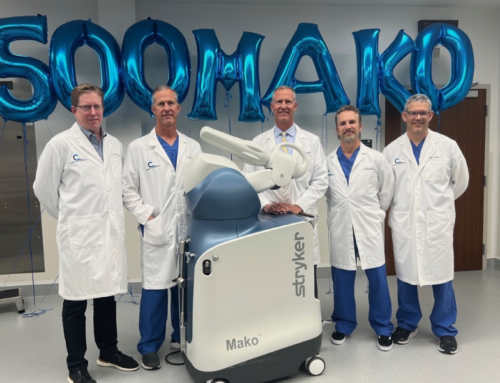 While the term surgery may be intimidating, orthopedic surgeons can and do use nonsurgical approaches to solving orthopedic problems in patients as well. In some cases, however, surgery is the best and safest course of action for the patient.
While the term surgery may be intimidating, orthopedic surgeons can and do use nonsurgical approaches to solving orthopedic problems in patients as well. In some cases, however, surgery is the best and safest course of action for the patient.
Though the same conditions may require different treatments in every patient, here are some of the most common orthopedic procedures.
Total Joint Replacement
For those patients that have been previously diagnosed with severe arthritis and needing pain relief and mobility improvement, a total joint replacement can be the best course of action. In this procedure, damaged parts to the joint are inspected and assessed by surgeons, who replace it with metal/plastic components that have been specifically shaped and designed to restore proper knee joint movement and functionality.
Total Shoulder Replacement
One does not always appreciate the value that shoulders provide the human body. However, should your shoulder get damaged, the impact to a patient’s life can be significant.
Replacing a damaged shoulder (including bone or cartilage) with a plastic or metal implement can improve the range of motion and equally importantly, reduce pain.
Spinal Surgery
Back problems are common in many patients, with an almost unlimited possible number of causes. While many people can and do live with minor back pain, there is a point at which back pain can impair their day-to-day life, and spinal surgery can be the answer.
One of the obvious but biggest benefits to having spine surgery is experiencing less pain – and with less pain, patients often find additional benefits like increased activity, better physical fitness and increased productivity.
A common type of back surgery is the Spinal Fusion. A spinal fusion joins (or fuses) spinal bones, called vertebrae together. This serves to restrict motion between the bones of the spine and limits the stretching of the nerves, reducing pain.
ACL Reconstruction
ACL stands for the Anterior Cruciate Ligament, which is the major stabilizing ligament of the knee.
While the media often talks about elite athletes needing ACL reconstruction, people from all walks of life can require ACL surgery. Orthopedic surgeons reconstruct this ligament when it ruptures, which can happen while participating in sports or twisting the knee the wrong way.
As part of this procedure, the surgeon removes the torn ligament, using the patients own tissue or the tissue of an organ donor to make a new ACL. Then they will attach the new ligament to the bone with screws or other binding devices to hold it in place.
As your knee heals, the bone tunnels created by the surgeon to bring new tissue through will start filling in, securing the new ligament, and restoring stability.
What are the 6 Most Common Orthopedics Related Injuries?

- Wrist fractures – it’s so easy to just put out a hand while you’re falling – and that can easily result in a distal radius fracture. In some cases, a cast and physiotherapy are all that’s needed; in others, surgery is required to stabilize the small bones that make up your wrist.
- Dislocated shoulder – an accident, collision or other trauma can cause your shoulder to dislocate; and once dislocated, the odds of it happening again increase.
- Stress fractures – because they don’t generate the same amount of pain that a traditional fracture does, they’re rarely diagnosed and treated properly. They can offer from too much stress and muscle wear and are common in the feet and ankles.
- Ankle and foot sprains – millions of people sprain their ankle each year. Usually RICE (rest/ice/compression/elevation) are good enough to fix it, but occasionally damaged ligaments and tendons will require more intensive treatment.
- Tennis elbow – this misnamed injury refers to an inflammation of the tendons around the elbow and is caused by any repetitive weight bearing movement.
- ACL tear – The ACL can be torn from any abrupt awkward turn with your knee.
Diseases and Conditions That Can Lead To Orthopedic Surgery
Here’s a list of some of the diseases and conditions that can lead to a patient requiring orthopedic surgery:
- Patellofemoral Stress Syndrome aka. Runner’s Knee
- Pulled Hamstring
- Rheumatoid Arthritis
- Rotator Cuff Injuries
- Sciatica
- Scoliosis
- Shin Splints
- Shoulder Dislocation
- Shoulder Pain
- Shoulder Tendonitis
- Soft-Tissue Injuries
- Spinal Cord Injury
- Spinal Tumors
- Tennis Elbow
- Torticollis
- Whiplash
- Giant Cell Tumors
- Groin Injuries
- Hand Problems
- Herniated Disc
- Knee Problems
- Lower Back Pain
- Lumbar Strain
- Golfer’s Elbow
- Multiple Myeloma
- Neck Pain
- Neurocutaneous Syndromes
- Osteochondroma
- Osteogenesis Imperfecta
- Osteosarcoma
- Paget’s Disease of the Bone
- Patellar Tendonitis
- Patellofemoral Stress Syndrome aka. Runner’s Knee
- Pulled Hamstring
- Rheumatoid Arthritis
- Rotator Cuff Injuries
- Sciatica
- Scoliosis
- Shin Splints
- Shoulder Dislocation
- Shoulder Pain
- Shoulder Tendonitis
- Soft-Tissue Injuries
- Spinal Cord Injury
- Spinal Tumors
- Tennis Elbow
- Torticollis
- Whiplash






